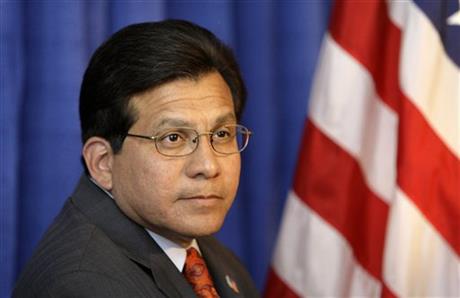
By KEN DILANIAN
In July 2004, despite growing internal concerns about the CIA’s brutal interrogation methods, senior members of George W. Bush’s national security team gave the agency permission to employ the harsh tactics against an al-Qaida facilitator the agency suspected was linked to a plot to disrupt the upcoming presidential election.
After weeks of torture that included being subjected to prolonged stress positions and sleep deprivation at a secret site in Romania, the prisoner, Janat Gul, begged to be killed. But he steadfastly denied knowledge of any plot, CIA records show __ leading interrogators to conclude he was not the hardened terrorist they thought he was, and that the informant who fingered him was a liar.
Yet there is no evidence the CIA relayed that information to the White House and the Justice Department, which continued to cite the case in legal justifications for the use of the brutal techniques.
In subsequent correspondence and testimony, the agency called the interrogation of Gul a success story on the grounds that it helped expose their original source as a fabricator.
The Gul case is an example of what a Senate investigation portrays as a dysfunctional relationship between the Bush White House and the CIA regarding the brutal interrogation program. The White House didn’t press very hard for information, and the agency withheld details about the brutality of the techniques while exaggerating their effectiveness, the report shows.
In an interview with The Associated Press, Alberto Gonzales, the former attorney general who was White House counsel when harsh CIA interrogations were approved, said it was not the White House’s responsibility to manage the program. Gonzales was the only former senior Bush administration official who agreed to speak on the record about the matter.
Once executive branch lawyers declared it legal for the CIA to use harsh methods on al-Qaida prisoners in secret facilities, Gonzales said, it was up to the spy agency to oversee the mechanics, punish abuses, and keep policymakers informed. So Bush officials can’t be blamed if CIA officers did things that were not authorized, or misinformed White House officials, as the report alleges, he said.
“Whether or not they followed the guidance, quite frankly, the oversight responsibility fell to the inspector general and general counsel of the CIA,” said Gonzales, who is now a law professor at Belmont University in Tennessee. “We just wouldn’t know about it, because that was not our responsibility.”
Gonzales said he was present during conversations that made it clear Bush knew details of the program early on. But Bush was not formally briefed by the CIA until 2006, at which time he “expressed discomfort” with the “image of a detainee, chained to the ceiling, clothed in a diaper, and forced to go to the bathroom on himself,” the report says.
Bush declined an AP request for comment, as did former Secretary of State Colin Powell and his deputy, Richard Armitage. Condoleezza Rice, who was national security adviser at the program’s inception, did not respond to interview requests. Nor did former Vice President Dick Cheney, former attorney general John Ashcroft, former White House counsel Harriet Myers, and former chief of staff Andrew Card.
Gonzales said he hasn’t read the Senate report and considers it a one-sided, partisan document because it was written by Democratic staffers — a view Cheney has also expressed publicly. Gonzales said he believes the coercive interrogations produced valuable intelligence and that the techniques should still be available to the CIA.
As for evidence of abuses, he said, “One of the lessons that one might get from all of this is the fact that war is a dirty business, and human beings sometimes they do things that they shouldn’t do.”
The torture of Janat Gul is a useful case study of how the CIA interrogations were overseen because it occurred two years into the program, after a report by the CIA inspector general had made clear that the harsh techniques were being employed far in excess of what had been envisioned in clinical Justice Department memos.
When the program began in 2002, many senior officials, including Powell and Rumsfeld, were not told about it. But by 2004, they had been, and Senate investigators determined that nearly every major national security official in the Bush administration was present at the meeting in which the decision was made to resume harsh techniques on Gul, the 110th of 119 detainees held and questioned by the CIA.
In the wake of the report, in June, CIA director George Tenet suspended use of harsh interrogation techniques. But in July, believing that Gul knew about a plot against the U.S., he got the Bush administration to grant permission to resume them. James Comey, then a top Justice Department lawyer and now the FBI director, was involved in the approval, records show. He has declined to comment on the Senate report.
“Janat Gul never provided the threat information the CIA originally told the National Security Council that Gul possessed,” the Senate report says.
In April 2005, the CIA’s chief of base in Romania wrote in an email that Gul “was never the person we thought he was.”
“He is not the senior al-Qaida facilitator that he has been labeled,” the email read. “… He was looking to make some easy money for little work, and he was easily persuaded to move people and run errands for folks on our target list.”
A U.S. counterterrorism official, who was not authorized to be quoted on the matter, said the CIA considers Gul “a hardened al-Qaida terrorist” who provided “dozens of reports about the group’s senior leadership and terrorist operations” after being subjected to harsh interrogation.



